differential DODGE POWER WAGON 2007 2.G Owners Manual
[x] Cancel search | Manufacturer: DODGE, Model Year: 2007, Model line: POWER WAGON, Model: DODGE POWER WAGON 2007 2.GPages: 492, PDF Size: 8.25 MB
Page 74 of 492
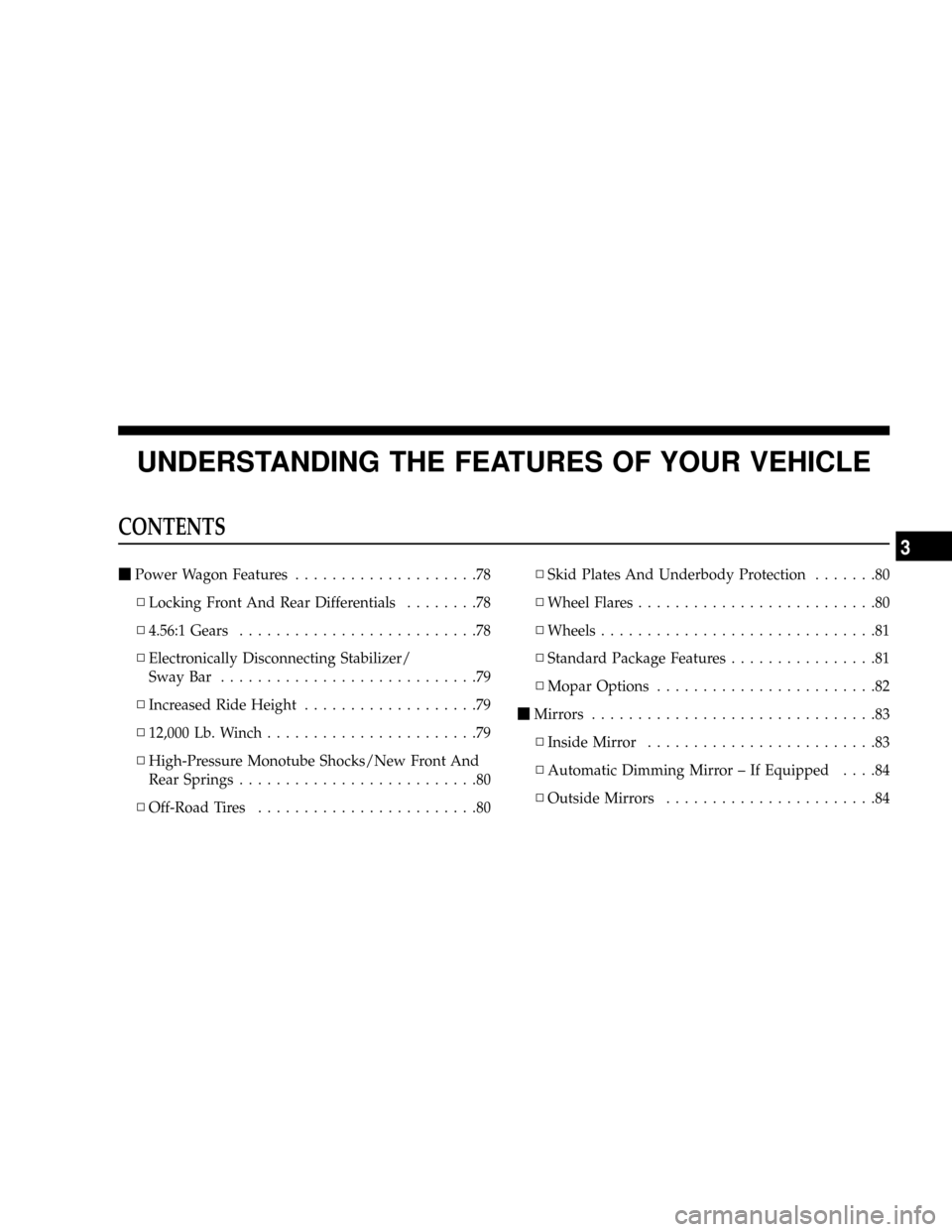
UNDERSTANDING THE FEATURES OF YOUR VEHICLE
CONTENTS
mPower Wagon Features....................78
NLocking Front And Rear Differentials........78
N4.56:1 Gears..........................78
NElectronically Disconnecting Stabilizer/
Sway Bar............................79
NIncreased Ride Height...................79
N12,000 Lb. Winch.......................79
NHigh-Pressure Monotube Shocks/New Front And
Rear Springs..........................80
NOff-Road Tires........................80NSkid Plates And Underbody Protection.......80
NWheel Flares..........................80
NWheels..............................81
NStandard Package Features................81
NMopar Options........................82
mMirrors...............................83
NInside Mirror.........................83
NAutomatic Dimming Mirror ± If Equipped....84
NOutside Mirrors.......................84
3
Page 79 of 492
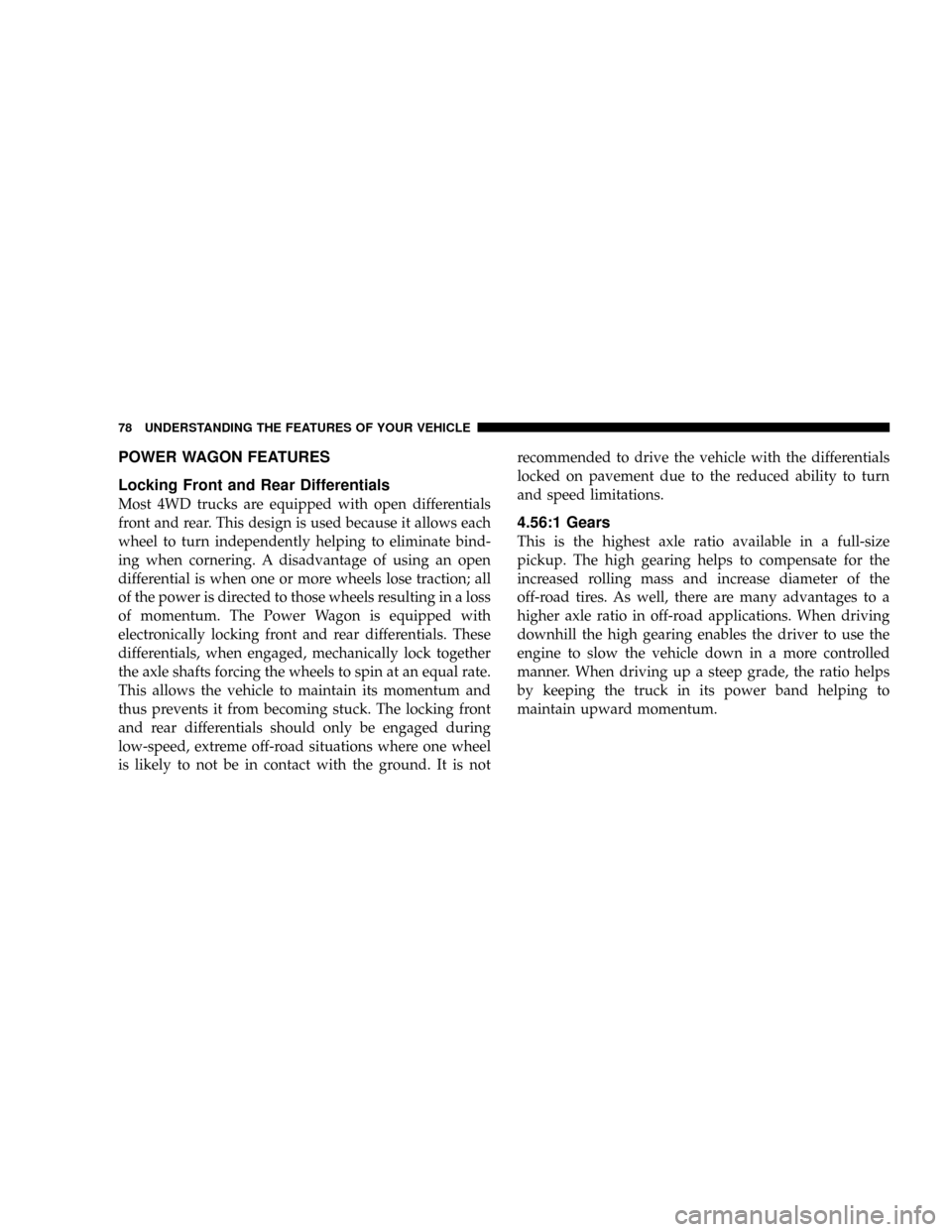
POWER WAGON FEATURES
Locking Front and Rear Differentials
Most 4WD trucks are equipped with open differentials
front and rear. This design is used because it allows each
wheel to turn independently helping to eliminate bind-
ing when cornering. A disadvantage of using an open
differential is when one or more wheels lose traction; all
of the power is directed to those wheels resulting in a loss
of momentum. The Power Wagon is equipped with
electronically locking front and rear differentials. These
differentials, when engaged, mechanically lock together
the axle shafts forcing the wheels to spin at an equal rate.
This allows the vehicle to maintain its momentum and
thus prevents it from becoming stuck. The locking front
and rear differentials should only be engaged during
low-speed, extreme off-road situations where one wheel
is likely to not be in contact with the ground. It is notrecommended to drive the vehicle with the differentials
locked on pavement due to the reduced ability to turn
and speed limitations.
4.56:1 Gears
This is the highest axle ratio available in a full-size
pickup. The high gearing helps to compensate for the
increased rolling mass and increase diameter of the
off-road tires. As well, there are many advantages to a
higher axle ratio in off-road applications. When driving
downhill the high gearing enables the driver to use the
engine to slow the vehicle down in a more controlled
manner. When driving up a steep grade, the ratio helps
by keeping the truck in its power band helping to
maintain upward momentum.
78 UNDERSTANDING THE FEATURES OF YOUR VEHICLE
Page 82 of 492
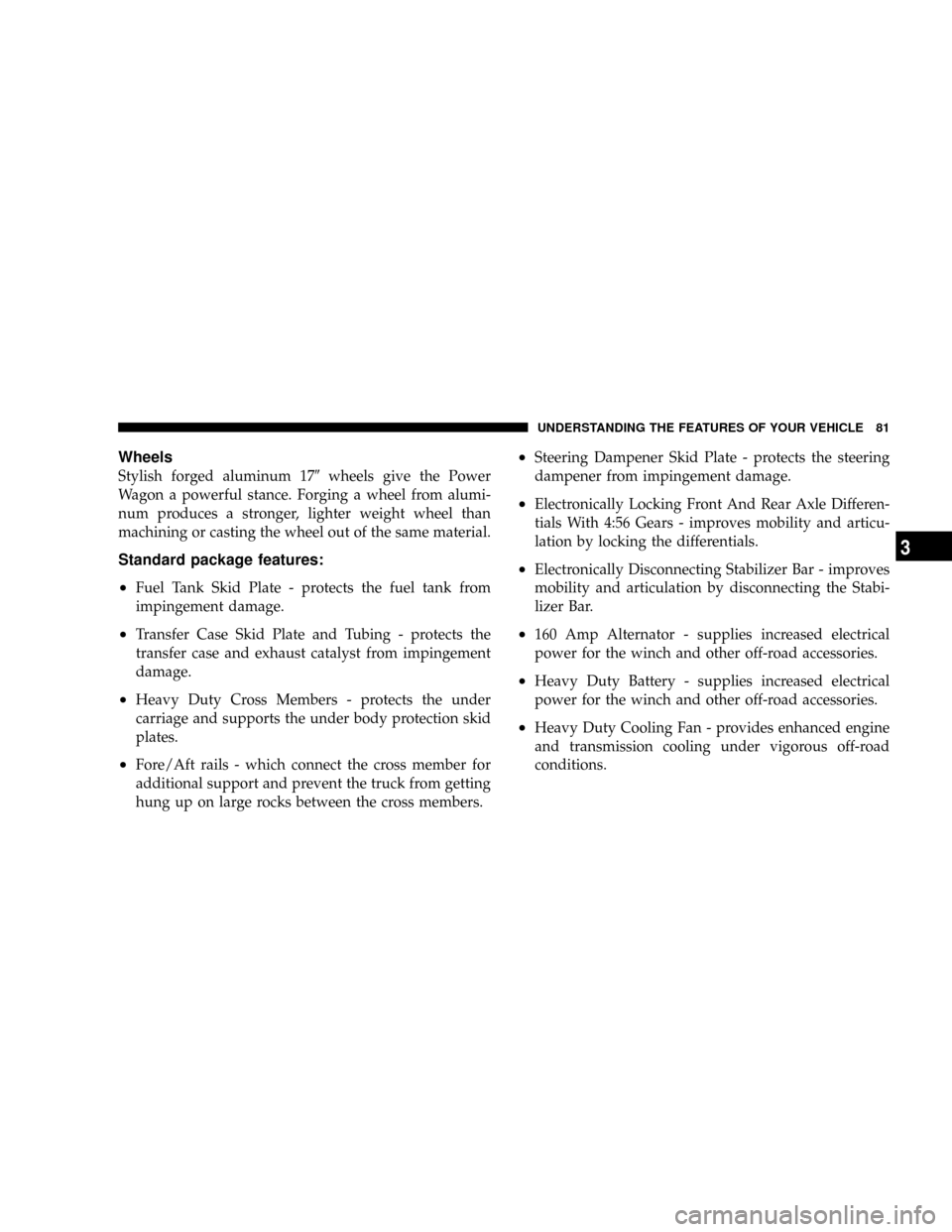
Wheels
Stylish forged aluminum 179wheels give the Power
Wagon a powerful stance. Forging a wheel from alumi-
num produces a stronger, lighter weight wheel than
machining or casting the wheel out of the same material.
Standard package features:
²
Fuel Tank Skid Plate - protects the fuel tank from
impingement damage.
²Transfer Case Skid Plate and Tubing - protects the
transfer case and exhaust catalyst from impingement
damage.
²Heavy Duty Cross Members - protects the under
carriage and supports the under body protection skid
plates.
²Fore/Aft rails - which connect the cross member for
additional support and prevent the truck from getting
hung up on large rocks between the cross members.
²Steering Dampener Skid Plate - protects the steering
dampener from impingement damage.
²Electronically Locking Front And Rear Axle Differen-
tials With 4:56 Gears - improves mobility and articu-
lation by locking the differentials.
²Electronically Disconnecting Stabilizer Bar - improves
mobility and articulation by disconnecting the Stabi-
lizer Bar.
²160 Amp Alternator - supplies increased electrical
power for the winch and other off-road accessories.
²Heavy Duty Battery - supplies increased electrical
power for the winch and other off-road accessories.
²Heavy Duty Cooling Fan - provides enhanced engine
and transmission cooling under vigorous off-road
conditions.
UNDERSTANDING THE FEATURES OF YOUR VEHICLE 81
3
Page 83 of 492
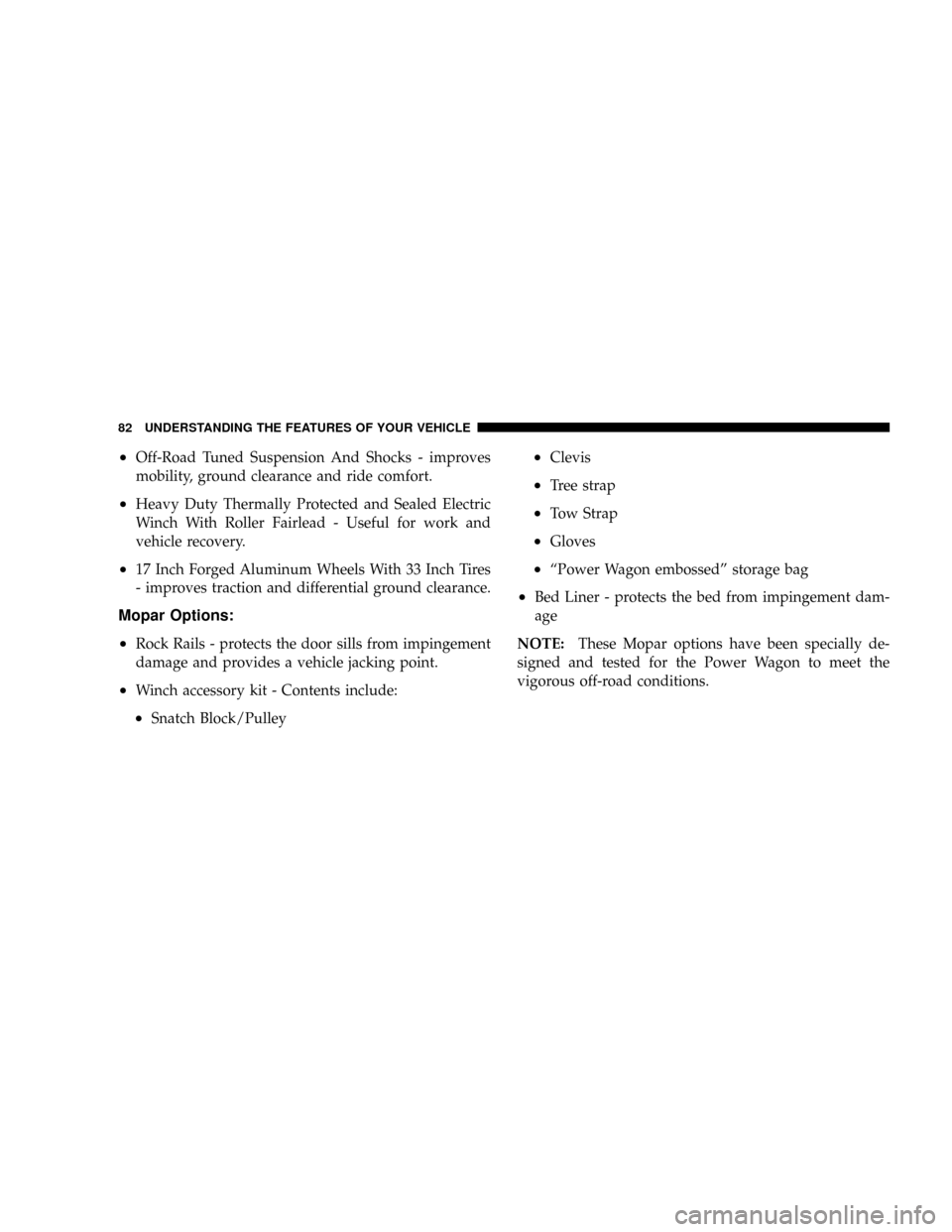
²Off-Road Tuned Suspension And Shocks - improves
mobility, ground clearance and ride comfort.
²Heavy Duty Thermally Protected and Sealed Electric
Winch With Roller Fairlead - Useful for work and
vehicle recovery.
²17 Inch Forged Aluminum Wheels With 33 Inch Tires
- improves traction and differential ground clearance.
Mopar Options:
²
Rock Rails - protects the door sills from impingement
damage and provides a vehicle jacking point.
²Winch accessory kit - Contents include:
²Snatch Block/Pulley
²Clevis
²Tree strap
²Tow Strap
²Gloves
²ªPower Wagon embossedº storage bag
²Bed Liner - protects the bed from impingement dam-
age
NOTE:These Mopar options have been specially de-
signed and tested for the Power Wagon to meet the
vigorous off-road conditions.
82 UNDERSTANDING THE FEATURES OF YOUR VEHICLE
Page 243 of 492

mLimited-Slip Differential Ð If Equipped.......262
mDriving On Slippery Surfaces..............263
mAxle Locker System.....................264
mStabilizer/Sway Bar System...............267
mPower Wagon ± Safe Off-Road Driving.......268
NOff-Road Driving Tips And Vehicle
Characteristics.......................268
NDriving In Snow, Mud And Sand..........273
NCrossing Obstacles (Rocks And Other High
Points).............................275
NHill Climbing........................278
NDriving Through Water.................281
NAiring Down For Off-Road Driving........283
NVehicle Recovery......................284NAfter Driving Off-Road.................288
mWinch Usage ± If Equipped...............289
NThings To Know Before Using Your Winch . . . 289
NUnderstanding The Features Of Your Winch . . 291
NWinch Accessories.....................293
NOperating Your Winch..................294
NRigging Techniques....................305
mParking Brake.........................308
mBrake System..........................309
NBrake Noise.........................310
NFour-Wheel Anti-Lock Brake System (ABS)Ð
If Equipped.........................310
mPower Steering........................312
242 STARTING AND OPERATING
Page 263 of 492

NOTE:Shifting into or out of 4L is possible with the
vehicle completely stopped, however difficulty may oc-
cur due to the mating clutch teeth not being properly
aligned. Several attempts may be required for clutch
teeth alignment and shift completion to occur. The pre-
ferred method is with the vehicle rolling 2 to 3 mph (3 to
5 km/h). Avoid attempting to engage or disengage 4L
with the vehicle moving faster than 2 to 3 mph (3 to 5
km/h).
NOTE:Do not attempt to shift to or from 4L while the
transmission is in gear or clutch is engaged.
Transfer Case Reminder Light
The four-wheel-drive operating light (4LOCK), located in
the instrument cluster, is used to alert the driver that the
front axle is fully engaged and all four wheels are
driving.
LIMITED-SLIP DIFFERENTIAL Ð IF EQUIPPED
The limited-slip differential provides additional traction
on snow, ice, mud, sand and gravel, particularly when
there is a difference between the traction characteristics
of the surface under the right and left rear wheels. During
normal driving and cornering, the limited-slip unit per-
forms similarly to a conventional differential. On slip-
pery surfaces, however, the differential delivers more of
the driving effort to the rear wheel having the better
traction.
The limited-slip differential is especially helpful during
slippery driving conditions. With both rear wheels on a
slippery surface, a slight application of the accelerator
will supply maximum traction. When starting with only
one rear wheel on an excessively slippery surface, slight
momentary application of the parking brake may be
necessary to gain maximum traction.
262 STARTING AND OPERATING
Page 266 of 492

The switch has three positions, AXLE UNLOCK, REAR
LOCK, and FRONT/REAR. Under normal driving con-
ditions the switch should be left in the AXLE UNLOCK
position. In the AXLE UNLOCK position, the front andrear axles are unlocked. In the REAR LOCK position, the
rear axle is locked. In the FRONT/REAR position, the
front and rear axles are locked.
NOTE:Even when the axles are in the AXLE UNLOCK
position, the limited slip differential in the rear axle still
provides torque biasing capability for moderate low
traction environments.
During the command to lock the axle, the indicator light
will flash until the axle is locked. After the lock command
has been successfully executed, the light will remain on
solid.
To lock the rear axle, place the vehicle in 4LO by
following the procedure in Four Wheel Drive Operation,
located in this section of the manual. Move the axle
locker switch position to REAR LOCK while traveling
less than 3 MPH (5 KM/H). The RR indicator light will
remain on when the rear axle is locked.
Rotary Locking Axle Switch
STARTING AND OPERATING 265
5
Page 272 of 492
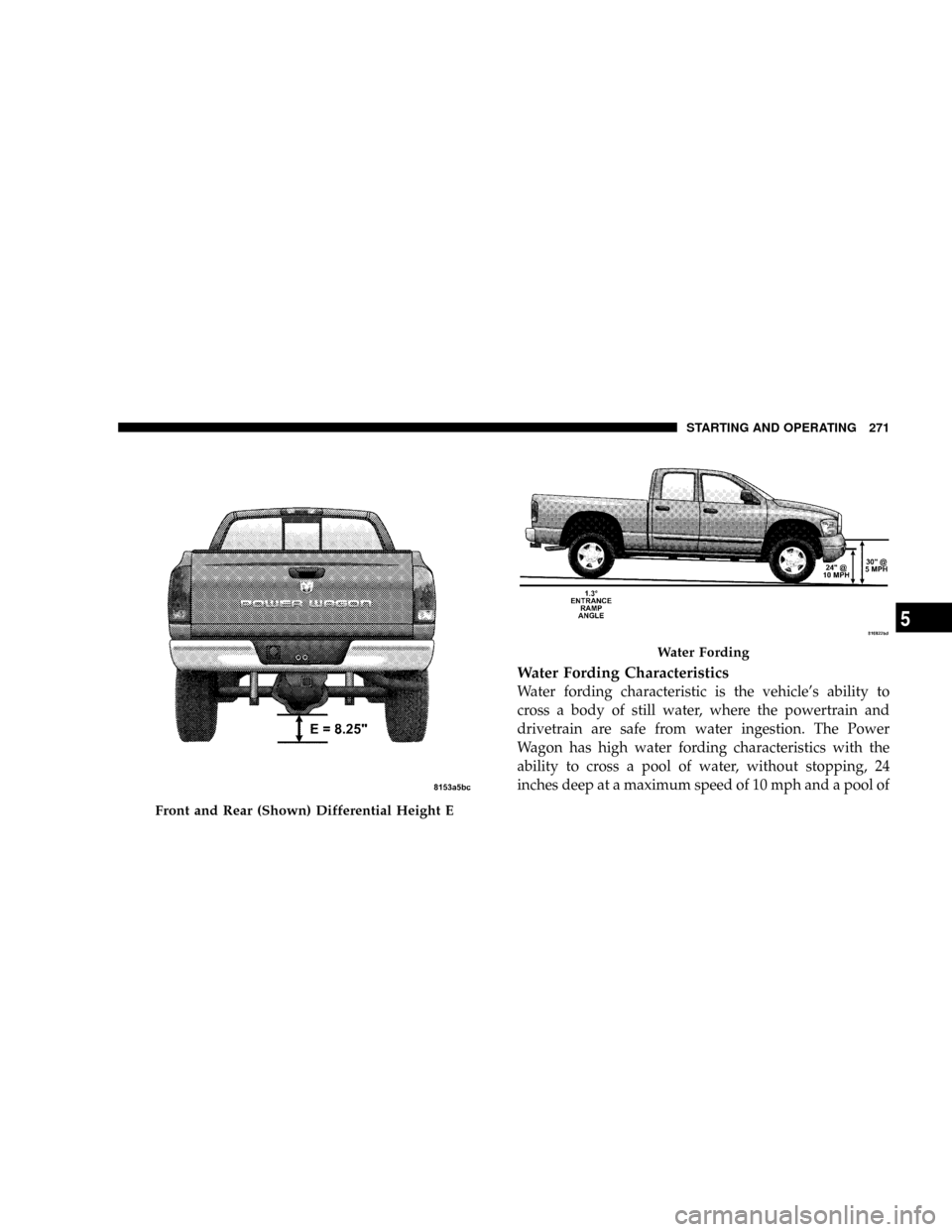
Water Fording Characteristics
Water fording characteristic is the vehicle's ability to
cross a body of still water, where the powertrain and
drivetrain are safe from water ingestion. The Power
Wagon has high water fording characteristics with the
ability to cross a pool of water, without stopping, 24
inches deep at a maximum speed of 10 mph and a pool of
Front and Rear (Shown) Differential Height E
Water Fording
STARTING AND OPERATING 271
5
Page 282 of 492
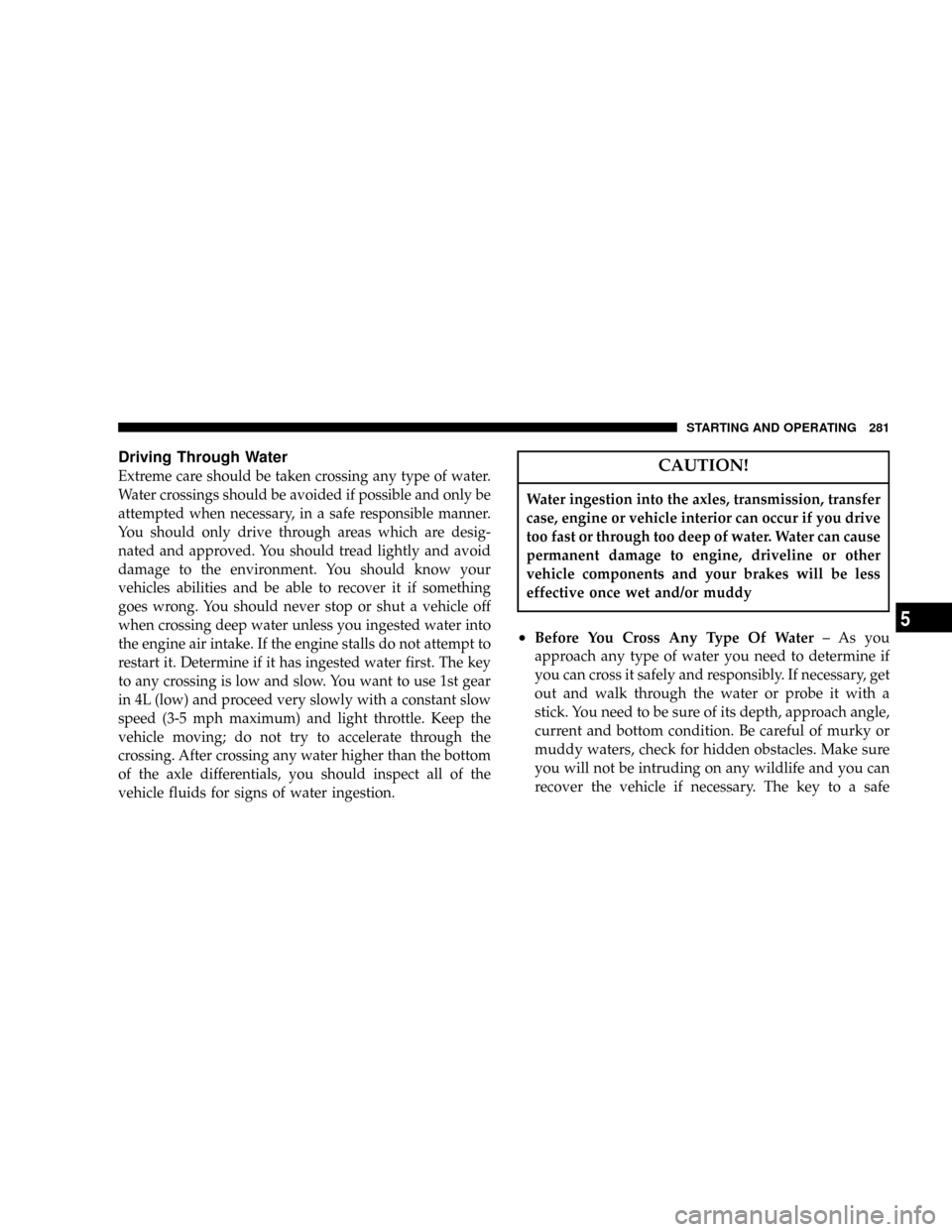
Driving Through Water
Extreme care should be taken crossing any type of water.
Water crossings should be avoided if possible and only be
attempted when necessary, in a safe responsible manner.
You should only drive through areas which are desig-
nated and approved. You should tread lightly and avoid
damage to the environment. You should know your
vehicles abilities and be able to recover it if something
goes wrong. You should never stop or shut a vehicle off
when crossing deep water unless you ingested water into
the engine air intake. If the engine stalls do not attempt to
restart it. Determine if it has ingested water first. The key
to any crossing is low and slow. You want to use 1st gear
in 4L (low) and proceed very slowly with a constant slow
speed (3-5 mph maximum) and light throttle. Keep the
vehicle moving; do not try to accelerate through the
crossing. After crossing any water higher than the bottom
of the axle differentials, you should inspect all of the
vehicle fluids for signs of water ingestion.CAUTION!
Water ingestion into the axles, transmission, transfer
case, engine or vehicle interior can occur if you drive
too fast or through too deep of water. Water can cause
permanent damage to engine, driveline or other
vehicle components and your brakes will be less
effective once wet and/or muddy
²Before You Cross Any Type Of Water± As you
approach any type of water you need to determine if
you can cross it safely and responsibly. If necessary, get
out and walk through the water or probe it with a
stick. You need to be sure of its depth, approach angle,
current and bottom condition. Be careful of murky or
muddy waters, check for hidden obstacles. Make sure
you will not be intruding on any wildlife and you can
recover the vehicle if necessary. The key to a safe
STARTING AND OPERATING 281
5
Page 376 of 492
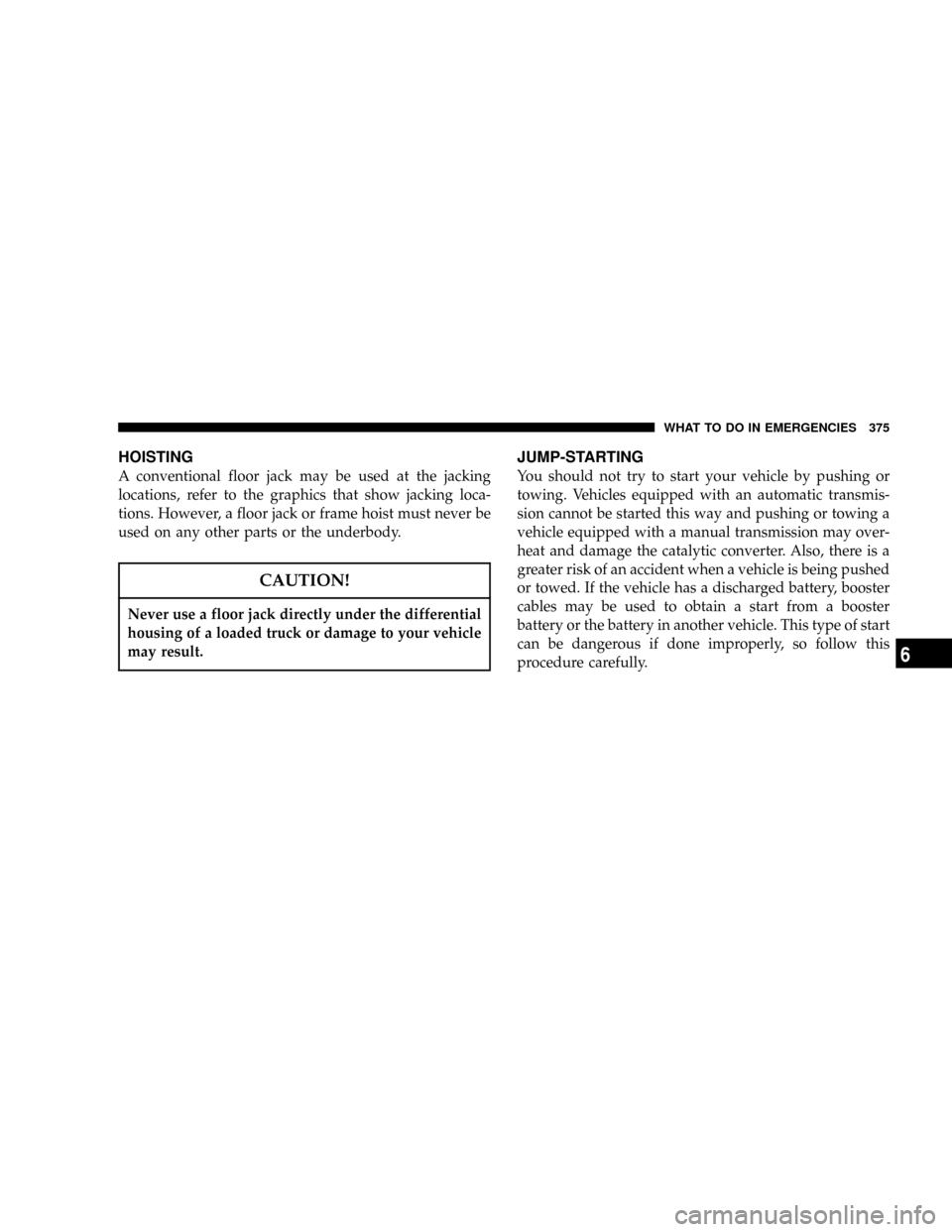
HOISTING
A conventional floor jack may be used at the jacking
locations, refer to the graphics that show jacking loca-
tions. However, a floor jack or frame hoist must never be
used on any other parts or the underbody.
CAUTION!
Never use a floor jack directly under the differential
housing of a loaded truck or damage to your vehicle
may result.
JUMP-STARTING
You should not try to start your vehicle by pushing or
towing. Vehicles equipped with an automatic transmis-
sion cannot be started this way and pushing or towing a
vehicle equipped with a manual transmission may over-
heat and damage the catalytic converter. Also, there is a
greater risk of an accident when a vehicle is being pushed
or towed. If the vehicle has a discharged battery, booster
cables may be used to obtain a start from a booster
battery or the battery in another vehicle. This type of start
can be dangerous if done improperly, so follow this
procedure carefully.
WHAT TO DO IN EMERGENCIES 375
6